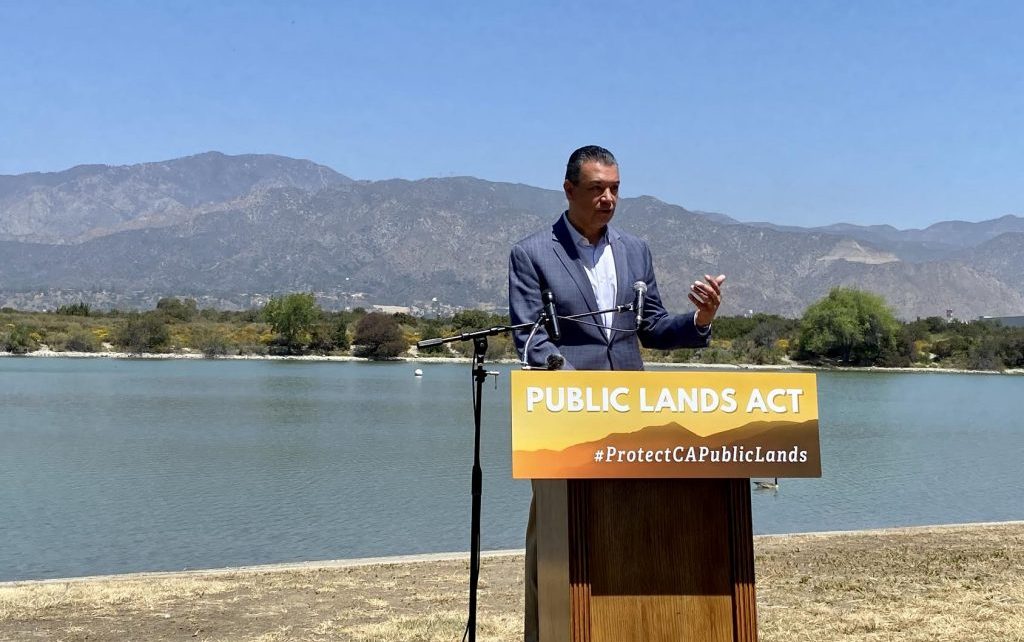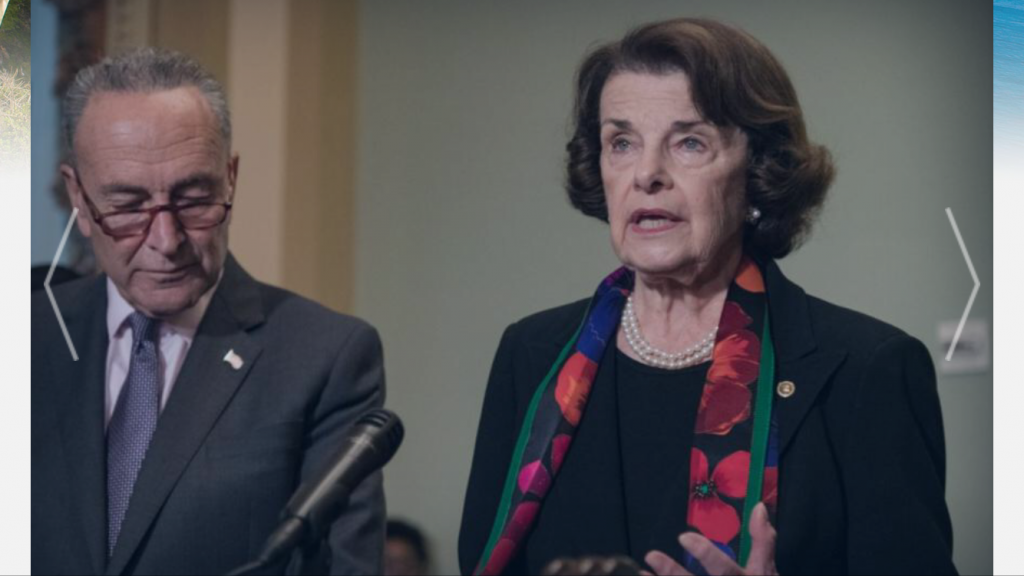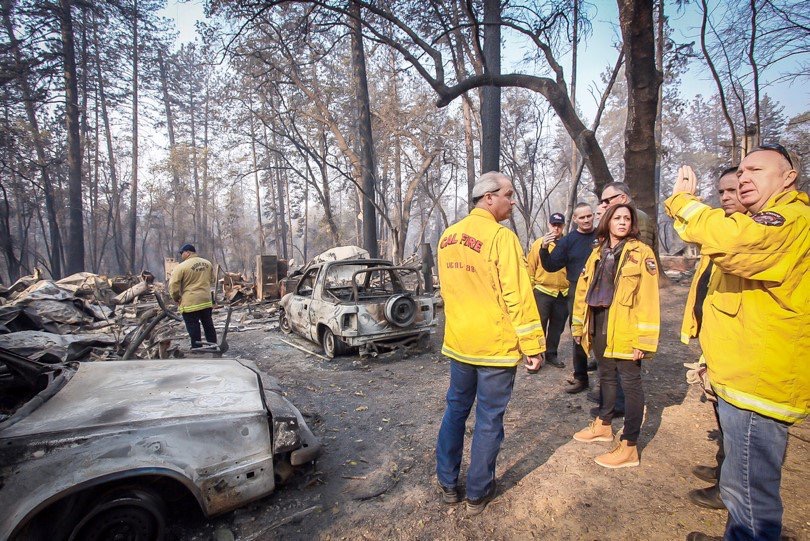
Senator Alex Padilla speaking in Irwindale on May 4, 2021. (Photo: Alex Padilla Senate website)
Senator Padilla Announces Proposal to Federally Protect Over 1 Million More Acres in California
Padilla’s PUBLIC Lands Act would focus on protecting areas of Southern, Northwest California
By Evan Symon, May 4, 2021 2:51 pm
Senator Alex Padilla (D-CA) announced on Monday that he will propose an expansion of over 1,000,000 acres of federally protected land in California.
The Senator’s proposal, known as the PUBLIC Lands Act, would combine 3 previously passed House bills by Congressional members such as Congresswoman Judy Chu (D-CA). The new and expanded protected areas would be located across the state, but with a large focus on the Los Angeles area and the Northwest part of the state.
The Northwest California Wilderness, Recreation, and Working Forests Act would be the first piece of legislation added to Padilla’s proposal, protecting 262,000 acres of public lands as wilderness, protecting 379 miles of new wild and scenic rivers, enacting forest and wildlife habitat restoration measures, and cleaning up areas damaged by illegal cannabis operations.
Another act added, the Central Coast Heritage Protection Act, would convert 288,000 acres of public land in the Los Padres National Forest and Carrizo Plain National Monument as wilderness, protect 159 miles of new wild and scenic rivers, and create a new scenic trail from Los Angeles County to Monterey County. The trail, which would be known as the Condor National Scenic Trail, would stretch for over 400 miles.
The final part added, the San Gabriel Mountains Foothills and Rivers Protection Act, would add over 109,000 acres to the San Gabriel Mountains National Monument, engulfing much of the western part of the western Angeles National Forest. 30,000 acres would be designated as wilderness in the national forest as well, with 45 miles of new wild and scenic rivers being added in the San Gabriel Mountains. A National Recreation Area would also be created to cover other areas of the San Gabriel and Rio Hondo areas.
The last proposed piece of legislation would also likely help pave the way for a new National Park, as 4 former National Recreation Areas and National Monuments have been elevated to becoming National Parks since 2018.
Senator Padilla proposed the PUBLIC Lands Act to add to areas of California that can be untouched, increase open spaces, stop developers from encroaching on protected areas, to help increase access to protected areas for lower income people who can not afford to travel to such areas farther away in the state, and to help combat climate change.
“Our public lands are one of our state’s greatest gifts – from the San Gabriel Mountains, to the Central Coast, and through Northwestern California’s forests and rivers. It is incumbent upon us to be thoughtful stewards of these special places so that our communities can enjoy them and benefit from America’s natural resources for generations to come,” said Senator Padilla on Monday during a speech in Irwindale, an LA suburb adjacent to the San Gabriel Mountains. “And we must do so in a way that reverses racial and economic disparities in access to nature and parks,” he added. “Some of the protected land in this bill serves densely populated areas of the state that don’t have equal access to nature, which will help rebalance this historic disparity in access to untouched wilderness.
“We will keep them as wild and untouched as possible for future generations to enjoy.”
A push for more federally protected land
Senator Dianne Feinstein (D-CA), who co-sponsored the bill, also noted that it would not only help fight climate change, but would help preserve some of California’s landscapes.

“From lush forests to majestic deserts to scenic coasts, California’s iconic landscapes have few rivals,” said Senator Feinstein in a statement on Monday. “In light of climate change, our growing population and challenges to the flora and fauna, protecting these special places is even more important. I’m pleased to partner with Senator Padilla on this effort and look forward to working with our colleagues to pass this bill.”
Many Republicans have come out in opposition to the bill, saying that it would create job loss in many of those areas due to possibly halting new developments, logging operations, and other industries that use forested or open lands.
“It’s not the question of job loss, but rather job replacement,” former forestry lobbyist Verna Tucker explained to the Globe. “Few question the need for more protected areas. It’s why we have seen such a huge upswing of protected areas in the last 10 or 20 years, with Donald Trump’s shrinkage of a few being the only really major exception. We’ve come a long way since the Spotted Owl controversy in the 1980’s after all. We don’t have loggers putting heads of endangered species on the grills of their trucks anymore to protest new protected areas.”
“But, with these areas being so close to urban areas, a lot of people are worried. Developers want more and more open land to build on, but more and more issues keep falling into place. Large new housing tracts have been squashed by wildfire concerns, water concerns, and other factors in recent years, some with the state itself actually blocking them from continuing. This has had many start to look farther out by these protected areas, but now the federal government is fighting back there too. They’re losing options fast, as many don’t want to go more smaller scale and replace older buildings in cities or suburbs. They’d rather just keep building new tracts.”
“Logging is another big concern. Many national forests can be used by logging companies, but if the U.S. Government keeps adding extra protections and designations like preserves to stop it from happening, they’ll lose places to turn too.”
“In return, you may get some national park jobs, maybe some outdoor companies will spring up for rentals, and maybe some hotels and other places may benefit from people staying several days. But we need to see hard figures. How many jobs lost vs. jobs gained. How much economic benefit would it bring in? We need to see those figures first. But they rarely provide them.”
The PUBLIC Lands Act is expected to pass in the Democratically-controlled House, but faces an uncertain vote in the divided Senate.
- Bill to Require Law Enforcement Disclosure if AI Was Used To Help Write Reports - August 7, 2025
- Gov. Newsom Files FOIA Request To ‘Expose True Cost’ Of L.A. Federal Troop Deployment for Anti-ICE Riots - August 6, 2025
- California Redistricting: How Newsom’s Plan Will Demolish Hard Fought GOP Gains - August 6, 2025








We just had historic damage and death in California from wildfires, in large part, due to poor forest management by the state and federal governments. Allowing lumber companies and private property owners to clear dead standing trees and brush, killed by the historic drought, would have helped lessen the damage. So now, these morons in Sacramento and D.C. want to INCREASE the acreage that the GOVERNMENT incompetently manages? NO WAY.
Last year I bought some 4’x8′ sheets of plywood from Home Depot. When I got home I noticed that it was made in China.
Mike, have you checked the price of plywood sheets at Home Depot, Lowes, lately? The inflated cost is adding $10,000 to the usual price (already high in California) of new homes.
Stuff Kamala or Barbara didn’t do …
Raymond I was thinking the same thing. We need to decrease the amount of land protected by our state.
Allow forest management to those who know what their doing. The loggers.
Wilderness designation would cripple fuel reduction or make it out of bounds entirely making the fire danger worse. We need a lot of logging and more saw mills to reduce the wildfire danger.
This is the most important part when we’re talking about constant, year-round, devastating killer fires that are only getting worse and worse and worse. It increasingly looks like they are SHOOTING for the Apocalypse.
Lets break down this 1 million acre land grab from an OHV Advocate point of view: (1) When a National Forest is turned into designated Wilderness, National Park or National Monument. EVERYTHING CHANGES. Period. There’s no question that EVERYTHING CHANGES. (2) Understand what you can and cannot do within these three land designations.. “Forest and Wildlife Habitat Restoration measures means NO OHV, NO CAMPING, ALL VEHICLE DIRT ROADS CLOSED, A LIST OF PROTECTIONS WILL BE CREATED. You may still be able to hike there, just as you can hike into a Wilderness or National Park now, but no OHV. (3) Senator Padilla said exactly what OHV does not want to hear: “We will keep them as wild and untouched as possible for future generations to enjoy.” (4) Yes, this will stop potential new developers from taking forest land away, so I agree that is good, but this goes way, way, way beyond stopping developers. (5) Logging. NO TIMBER SALES. This means, most likely (based on what we’ve seen over the past 30 yrs) means that all the new “protected land” will be returned back to “nature” and Forest Management will cease. No Forest Management 100% leads to overgrowth and an extremely dangerous scenario. This is not and should not be described as Protecting Public Land FOR our use. It should be described as Protecting Public Land FROM our use. This is all bad for Outdoor Recreation in California.
Good job, Mike. Thanks.
Yes, this is excellent, thanks a million times Mike.
Let’s not forget what else happens. Not simply no OHV, no motorized or mechanical transport of any kind. Mountain bikes are a no go. Boats cannot be motorized. Paddles or oars, horses or your own feet, that’s it. In some cases these restrictions are sensible, but politicians keep expanding the definition of what needs protection. Far from ‘protecting’ wilderness for the underprivileged (notice how the Dems worked that class/race angle again), it effectively denies access to thousands of acres to all but the few hardy souls who have the skills, determination and free time to spend days or weeks trekking into the backcountry. This severely limits opportunities for activities such as hunting, trapping, prospecting, metal detecting, etc. for most people. That’s the point, of course; kicking John Q. Public out.
Just imagine what government agencies and private corporations could hide from the public on land we can’t access. Then there’s good ol’ quid pro quo. I’ve heard stories of out of season hunting, fishing and camping trips arranged for big campaign donors and other “connected” individuals in these areas. I’ve never been able to confirm them, but would it really be that surprising, given everything else we’ve seen over the last ten years?
John, I would be interested in seeing a map of this proposed addition. If it includes parts of the Klamath River basin in N. California, that is a former gold mining area and recreational area. The Crocker Family home (of Crocker Citizens National Bank) is up there.
My Dad tried to fight it in the1970s. The Sierra Club was behind a lot of this nonsense. They used the lie that OHV were killing the desert tortoises. OHV are the only people that ever get into some of these areas because most of this terrain has no water and hikers can’t carry enough to get more than a few miles from any road. It’s Environazis….
Folks, this is all about the United Nations Agenda 21, 2030 and 2045 to “re-wild” 90% of our Country. The plan is to move all of us use-less eating humans into 10 FEMA regions that are all big urban areas, into high density, tiny apartments, that surely most/all of you have seen going up all over the place in the past several years. Funny how these apartment complexes all look the same no matter which State you are in!
These re-wilded, no go zones mean that there will be no humans allowed, at all! Please, go look at the website stopthecrime.net by Deborah Tavares. She has been ringing the alarm bells for years! We need to wake up and stop all of this BS now before it is too late! This is climate change on steroids and we humans are the target!
Maybe in addition to what the great commenters here have already described (thank you! didn’t know a lot of it) the Feds needs a place to put all the rest of the millions of unaccompanied minor (and major) illegal immigrants they want to see streaming across the border.
Beware the wild and scenic river designation. It is used as a weapon against everything in the area. Just look at what the enviro-Nazi’s did to Yosemite. They extended the protections into Yosemite valley (this was never the intent) for the purpose of dismantling all the concessions in the park and they are using it to prevent repairs to hwy 140 where the rockslide wiped out the road.